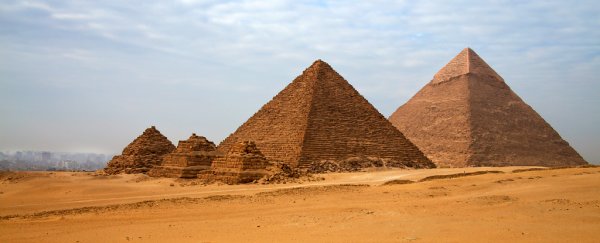For centuries, the pyramids of Giza have puzzled researchers - not just their mysterious voids and hidden chambers, but exactly how ancient Egyptians built such impressive structures without modern technology.
One of the most confounding issues is how the structures became so perfectly aligned.
Although it's slightly lopsided, overall the square sides of the 138.8 metre (455 foot) Great Pyramid of Giza - also known as the Great Pyramid of Khufu - are pretty damn straight, and aligned almost perfectly along the cardinal points, north-south-east-west.
"The builders of the Great Pyramid of Khufu aligned the great monument to the cardinal points with an accuracy of better than four minutes of arc, or one-fifteenth of one degree," writes archaeologist and engineer Glen Dash in a new paper in The Journal of Ancient Egyptian Architecture.
In fact, all three of the largest Egyptian pyramids - two at Giza and one at Dahshur - are remarkably aligned, in a way you wouldn't expect to see from an era without drones, blueprints and computers.
"All three pyramids exhibit the same manner of error; they are rotated slightly counterclockwise from the cardinal points," Dash adds.
While many hypotheses exist as to how they did this - using the pole star to align the pyramids, or the Sun's shadow - no one has been able to nail down exactly how these worked.
Now Dash has another, simpler idea. His latest research suggests that the Egyptians roughly 4,500 years ago could have used the autumnal equinox to achieve perfect alignment.
The equinox is regarded as the moment twice a year when the plane of Earth's equator passes through the centre of the Sun's disc, and the length of day and night are pretty much equal.
Previously equinox measurements had been overlooked as a possible alignment method, as it was assumed it wouldn't provide enough accuracy.
But Dash's latest work show that there's a way this could have worked - using a rod known as a gnomon.
To figure this out, Dash actually did his own experiment, starting on the first day of the fall equinox in 2016 - 22 September 2016 - and using a gnomon to cast a shadow.
He tracked the point of the shadow at regular intervals, forming a smooth curve of points. And at the end of the day, with a taut piece of string wrapped around the pole, he intercepted two of the points of the curve and created an almost perfect line running east-west.
This is also known as the Indian circle method, and you can see it in action below.
 Dash, JAEA (2018)
Dash, JAEA (2018)
"On the equinox, the surveyor will find that the tip of the shadow runs in a straight line and nearly perfectly east-west," writes Dash.
He also showed that the degree of error is slightly counterclockwise - which is similar to the slight error found in the alignment of the Khufu and Khafre pyramids at Giza, and the Red pyramid at Dahshur.
The experiment was conducted in Connecticut, US, but Dash said the same thing should work in Egypt.
In fact, all ancient Egyptians would have needed to align the pyramids, he told Owen Jarus at Live Science, was a clear, sunny day.
He added that the Egyptians would have been able to work out the fall equinox by counting 91 days forwards from the summer solstice.
But although his paper shows that this technique could have been used to align the pyramids, we still don't have any solid evidence that was actually the case.
"The Egyptians, unfortunately, left us few clues. No engineering documents or architectural plans have been found that give technical explanations demonstrating how the ancient Egyptians aligned any of their temples or pyramids," writes Dash.
While we might never know what really happened, this new paper makes an interesting point -that something as simple as mapping shadows during the fall equinox could have been sophisticated enough to align some of humanity's most recognisable ancient structures.
The paper can be read in full in The Journal of Ancient Egyptian Architecture.
